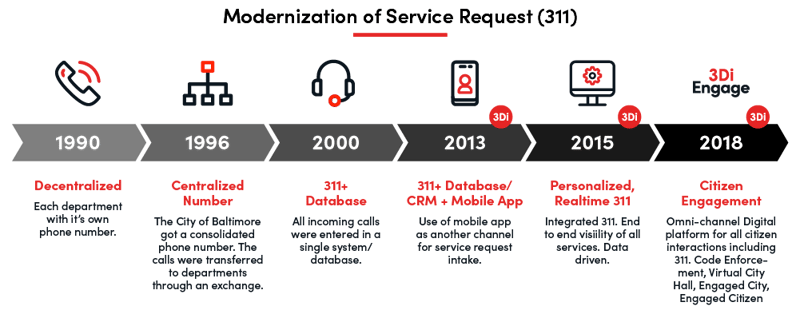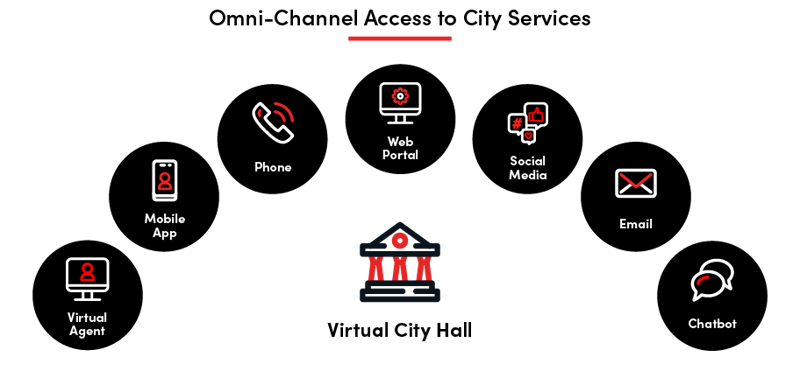The ways that local governments interact with their residents have been steadily improving for decades. From the days of making a trip to City Hall just to apply for a permit or pay a fine, to the modern era, when most municipal tasks can be accomplished online.
But keeping up with the rapid pace of change set by consumer technology — and the expectations of residents evolving alongside it — remains a challenge for local leaders. One which has led local governments to explore tools and methodologies aimed at elevating the experience they provide for their communities, most importantly as it relates to transparency, accountability, and efficiency.
During the early days of the pandemic, residents and government officials alike experienced firsthand the frustrations of an outdated system when state websites across the country crashed en masse as an unprecedented number of people logged on to apply for unemployment benefits. Emergency situations aside, many local governments have begun to realize the need for “playing catch up” when it comes to community engagement.
While the widespread adoption of 311 numbers was a major step forward, the technology is no longer cutting edge; call centers are resource-intensive, and many residents, particularly young people and those whose first language isn’t English, are more comfortable using other channels, like web portals or mobile apps.
To meet residents where they are and build strong connections with their communities, local leaders across the country are adopting smart, user-friendly software platforms that take community engagement beyond a simple hotline system. The right community engagement software not only streamlines processes and busts information silos internally, it offers residents a digital platform for interacting with their local government – providing a Virtual City Hall-like experience – that’s as easy to use as what they’ve come to expect from private companies.

Community engagement through the years
The first major leap forward in the modern era for community engagement came in 1996, when the city of Baltimore, MD adopted the first consolidated number to route incoming, non-emergency calls. Prior to this first 311 number, residents had to search a long phone directory for the appropriate city department to handle their question or service request.
By 2000, local governments began compiling 311 calls into central databases, creating goldmines of data on the types, locations, and costs of issues arising in their communities. These databases also created an opportunity for greater transparency. Many cities launched publicly available 311 datasets to let residents see the types of service requests they were receiving and how they were being handled.
With the adoption of smartphones, cities began launching mobile 311 apps to allow residents to easily find relevant information or flag problems on the ground, like potholes or broken streetlights. And as integrated data capabilities became widely available, cities were able to provide residents with end-to-end visibility of services through personalized, real-time 311. A step which naturally led to the adoption of omnichannel citizen engagement, inclusive of 311, code enforcement, and Virtual City Hall.
Despite these advancements, most local governments still have room to modernize their community engagement. Clunky websites and poorly built apps create a frustrating user experience for residents. Information silos still linger in organizations that haven’t invested in breaking them down, which makes sharing data and collaboration between agencies a headache. And the data culled from central databases is only as valuable as the insights you’re able to draw from it — which depends heavily on the software used to sort and analyze it.
The right community engagement platform will offer a seamless experience for residents across multiple channels, breaking down information silos, automating processes wherever possible, and providing valuable data insights that can improve how your city is run.

An omnichannel approach to community engagement
As consumers in the age of the internet, we expect options. If we need to contact a company’s customer service, we expect to be able to do so via email, web application, text, or social media — not just a phone number. Citizens expect no less from their local governments, especially younger citizens: a seamless consistent experience delivered across all customer engagement channels (web, mobile, email, SMS, social, chat, phone, and virtual assistants). A recent survey from BankMyCell found that 75% of millennials avoid phone calls because they find them too time-consuming. More than 80% of millennials reported feeling anxiety about talking on the phone.

Other residents, including the hearing impaired or those whose first language isn’t English, may also find phone calls difficult. Upgrading your city’s 311 capabilities to a software platform with a streamlined, consistent experience across multiple channels, including web portals and mobile apps, expands your reach, improves access, and helps you engage citizens who would prefer not to talk on the phone.
The end of data silos
Having a network of separate, unintegrated systems is a recipe for poor communication between departments, wasted resources, and a haphazard user experience.
When agencies don’t share information automatically, it’s easy to miss important insights. Employees on different teams may waste time working on the same problem, unaware it’s already being handled elsewhere. A resident may feel that they’re starting from scratch every time they’re transferred to a new department if there’s no effective CRM system in place allowing the new representative to pick up right where the last one left off. And having to re-enter the same information across multiple pages can leave residents with the impression that their local government is a convoluted maze, rather than one united front working for them.
The next generation of community engagement software is built on top of powerful platforms that can be used for multiple government functions, from housing to bill pay to 311. Where separate systems are in place, they should be fully integrated to eliminate silos, facilitate collaboration, and provide the best possible experience for residents.
Automation is key
Every time human input is required by a system, it introduces a chance for human error. Automating processes not only saves time and valuable resources, it eliminates opportunities for mistakes.
The constant flow of service requests coming into an agency require follow-up, both internally and with the resident, and must move along stages of the workflow, from request to completion. This process shouldn’t depend on one employee remembering to move a case along manually. The best community engagement software automates workflows, allowing government employees to handle more requests, more efficiently, while providing a consistent, seamless experience to residents.
One large city that adopted 3Di’s Service Request Management product, for instance, was able to handle up to 3.5 million more service requests per year, while slashing call center wait times from 30 minutes to less than 60 seconds for some time periods. This is the kind of solution that saves time and money, while improving the quality of the service.

Harnessing the power of the cloud
Citizen engagement software that hosts data using major cloud-based services providers offers a range of advantages. First, it eliminates the cost for onsite IT staff to set up and maintain servers and networks, saving time and money. It also boosts security by providing cutting-edge, offsite protection for a community’s most sensitive data.
The best citizen engagement software platforms will protect your information by hosting it with an industry-leading cloud services provider. Working with a major brand like Amazon Web Services not only makes set-up easy and cost-efficient, it keeps data safe with top-of-the-line security features that smaller cloud services providers can’t offer.
Community engagement, beyond a hotline
After decades spent helping local governments modernize their service requests, we know that the future of community engagement looks less like a switchboard and more like a virtual city hall. Having the right tools for the job is essential, and the right citizen engagement software – one which is intuitive, relevant, and scalable – can be the difference between serving more residents more effectively and falling behind the times.
To learn more about how smart software solutions can help you better reach your constituents, check out this guide.



